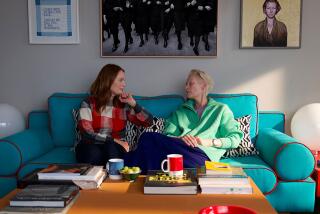Damon Lindelof never intended for ‘The Leftovers’ to be so bleak
Damon Lindelof understands you want answers.
It’s a familiar refrain throughout his prodigious film and TV career. He heard it about the end of “Lost,” which he co-created. Again, about the whole of “Prometheus,” which he co-wrote. And most recently, about HBO’s “The Leftovers,” which returns for its second season Sunday.
Adapted from the same-titled novel by series co-creator Tom Perrotta, “The Leftovers” takes place in a post-something world where 2% of the planet’s population suddenly disappears. Neither the book nor the television show offer an explanation for the bloodless cataclysm, and the narrative force of both works focus on those left behind as they grapple with the staggering and mystifying loss.
SIGN UP for the free Indie Focus movies newsletter >>
The series’ first season was met with mostly positive reviews, but they usually contained caveats. The show, which stars Carrie Coon, Justin Theroux, Amy Brenneman and Ann Dowd, was almost universally praised for its compelling characters, storytelling ambition and poignancy.
Many critics, however, found the tale confusing, uneven and even chaotic. And even critics who liked the series were sometimes overwhelmed by what they viewed as its unyielding bleakness.
“If you had said to me before shooting the pilot, ‘What are five adjectives that you would use to describe how this world feels?’ depressing or even sad were not my intention,” said Lindelof. “There’s a difference between sad and depressed. I’ve been sad and it’s natural to feel sad. When my dad died, I was really sad. I wasn’t depressed. Depression, there’s something unnatural and unending about it and it started to feel like the only authentic way to present the characters in ‘The Leftovers.’”
Before filming the first season, Lindelof and pilot director Peter Berg spent time in and around Newtown, Conn., the town where the Sandy Hook Elementary School shooting occurred. They wanted a portrait of a community processing an unthinkable tragedy.
The pair was especially struck by the community’s decision to demolish the school site and replace it with a brand new one on the same ground.
“It’s ritualistic,” said Lindelof. “It made sense to everybody. Absolutely. You’ve got to knock it down.”
As Lindelof spoke of Newtown, he seemed haunted. He recalled once when he and Berg entered a bar during their visit and the locals knew who was in town to rubberneck.
“I suddenly realized,” he said, “‘I’m a looky-loo. Why am I here?’”
Tragedies such as Sandy Hook, or even this week’s fatal shootings in Oregon, often lead to an intense period of reevaluation, especially about belief systems. How did this happen? Why did this happen? Why did this happen to me?
Sometimes, the system of belief for the characters in “The Leftovers” collapses, some find their faith strengthened and others turn to what can be described only as a form of religious fanaticism.
In the wake of such misfortunes, Lindelof recognizes the powerful need people have to make sense of the unexplainable, even for a loose, small collection of so-called Newtown truthers who argued the disaster that befell the town was orchestrated.
“They make sense to me,” Lindelof said. “I want to live in a world where all of those kids are still alive, where they were shipped off to Bermuda and this was people staging this thing.”
When asked if he believes in God, Lindelof doesn’t flinch.
“The short, unqualified answer is yes,” he said. “Yes, passes the polygraph.”
He’s candid with all his beliefs. No, to ghosts. Yes, to prayer. But he’s not sure where the line is between mental illness and religious fervor.
“It’s one of the most fascinating questions about religious ideology,” he said. “We live in a day and age where we can’t tell the difference between crazy and prophetic.”
It’s this draw to tragedy and triumph that guides the new season of “The Leftovers,” which moves from upstate New York to a small town in Texas that now goes by “Miracle.” The spot was the only town to have not lost a single person during the recent departures.
Lindelof explained he is aware of the failings of the first season, which drew roughly more than 7 million viewers per episode across all HBO platforms. He’s determined to correct them.
“There was a lack of narrative emotional focus in Season 1,” he said, adding that they’ve even tweaked the direction to clarify the point of view of characters
to make sure the audience is properly centered.
The new setting allows for fresh characters, among them Emmy winner Regina King, who plays Dr. Erika Murphy, who lives with her husband, John (Kevin Carroll), and their twin teens. At first, the town seems idyllic, but naturally that facade changes.
But for all the changes of the second season, perhaps none are so telling as the show’s new opening credits. Gone are the sweeping orchestration of the first season and its massive fresco depicting the departure. In its place is a twangy, up-tempo ditty by Iris DeMent called “Let the Mystery Be.”
Though the song was written more than two decades ago, it could have been written as the Leftovers’ mission statement.
“They all came from
Everybody’s worryin’ ‘bout where they’re gonna go
When the whole thing’s done
But no one knows for certain and so it’s all the same to me
I think I’ll just let the mystery be”
Lindelof understands that people wants answers. But he’s content to let the mystery be.
--------------------
‘The Leftovers’
Where: HBO
When: 9 p.m. Sunday
Rating: TV-MA (may be unsuitable for children under the age of 17)
ALSO:
Central Casting to HBO actors: Drop your pants
Lena Dunham dumps Jezebel, drags Twitter and (maybe) ends ‘Girls’
How does ‘CSI’ measure up to procedural powerhouse ‘Law & Order’?
More to Read
The complete guide to home viewing
Get Screen Gab for everything about the TV shows and streaming movies everyone’s talking about.
You may occasionally receive promotional content from the Los Angeles Times.







